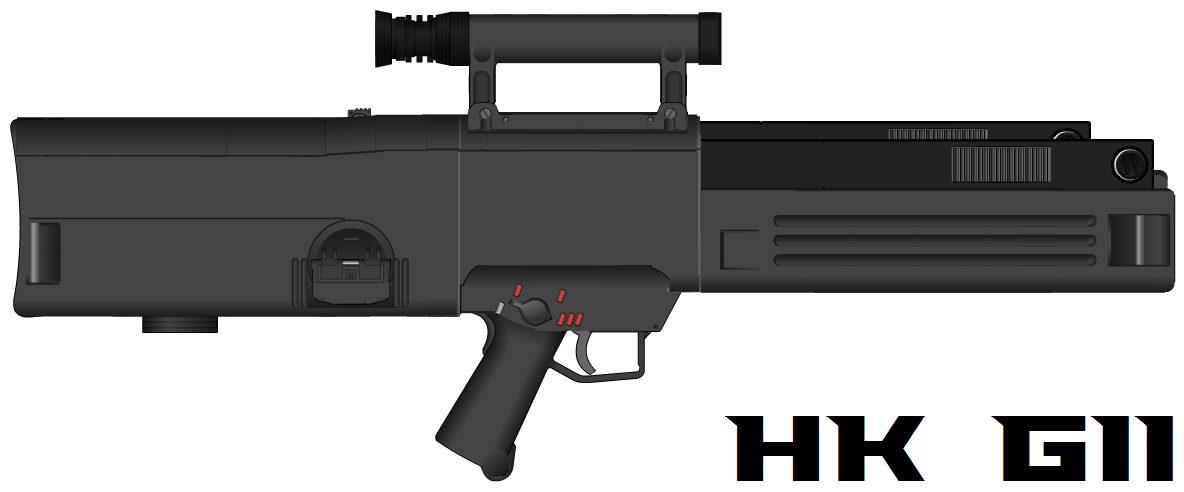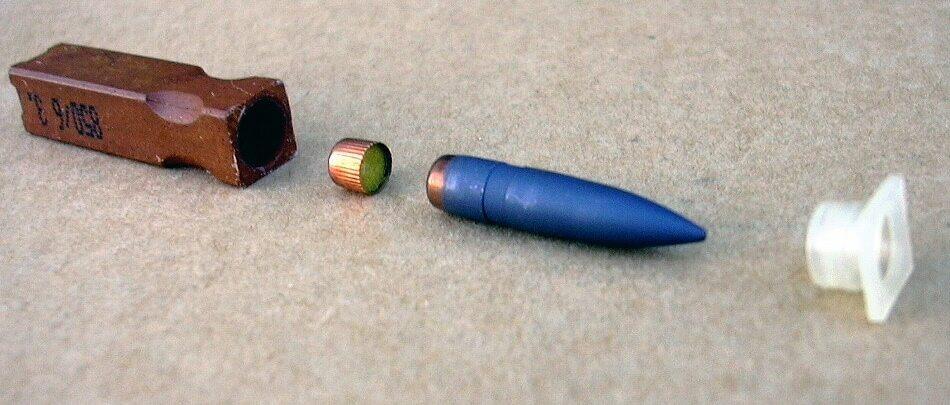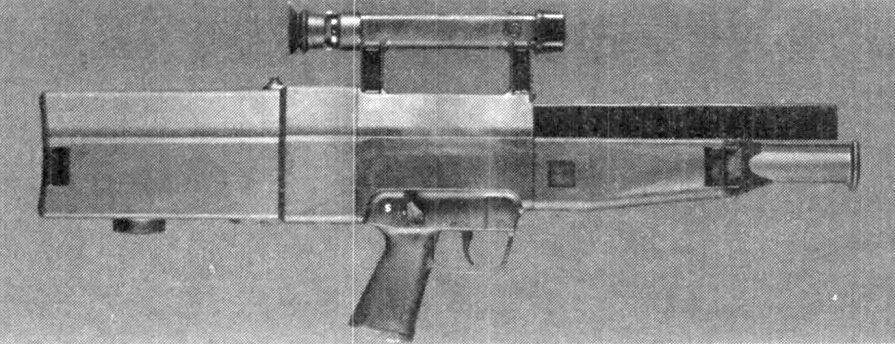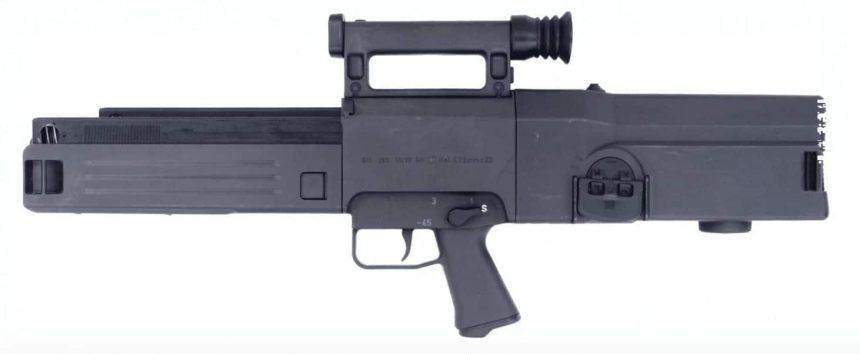The Heckler & Koch G11 is probably the most revolutionary weapon to appear anywhere in the past 40 years or more, involving a totally new type of mechanism and a careless cartridge. It was planned to be adopted by the West German Army in 1990, but events overtook it, and the G11 and the company who developed it were among the first victims of the ‘peace dividend’.
Design
The design began in the late 1960s when the West German Army, looking ahead, asked for new rifle designs. They laid down a few conditions except that it had to be able to fire a three-round burst with a dispersion of not more than two mils between each bullet impact.
This meant that at 500 meters the extreme spread between three shots had to be under one meter – and we are talking about a three-round burst, not three individual aimed shots. Heckler & Koch soon realized that this meant a rate of fire in excess of 2000 rounds a minute in order to get three rounds off before the barrel moved from the point of aim, and this, in turn, meant devising a totally new mechanical solution.

Caseless cartridge
Their first move was to develop a caseless cartridge, in association with Dynaimt Nobel. This has two advantages: it is lighter than a conventional brass-cased round, so the soldier can carry more of them; and the rifle mechanism no longer has to cater for the extraction and ejection of the spent case. This development took time; the first design was a block of nitro-cellulose propellant and plastic binder, with a bullet in the front and a combustible cap in the rear.
It worked, but overheated the rifle, leading to cook-off problems in which a round loaded into a hot chamber suffered spontaneous combustion from the induced heat. The problem was eventually overcome by the development of a new ‘High Ignition Temperature Propellant’ which requires a temperature some 100 degrees C higher than nitro-cellulose before it cooks off.

Mechanism
The mechanism in the Heckler & Koch G11 is complex but can be summed up by saying that it is a rotating breechblock with a chamber bored in it. This revolves in line with the barrel. By operating an external knob the chamber is turned vertically, and a cartridge is fed in from the magazine, which lies above the barrel. Another turn of the knob and the block is rotated so that the chamber lies behind the barrel.
Pressing the trigger allows a firing pin to strike the cap; the cap and propellant are entirely consumed and the bullet is driven out of the barrel and the power used to rotate the breechblock, collect a fresh round and rotate it again ready for the next shot. To unload, the knob is turned backward and the cartridge drops out through a hole in the bottom of the rifle.
As might be imagined, the greatest problem to be overcome in this design is sealing the breech so that all the gas drives the bullet out and does not escape between the chamber and the barrel; the precise details are secret, but they appear to be very similar to the sealing of a Wankel automobile engine.
The mechanism, together with the barrel, is completely concealed within an all-enveloping plastic casing. This is formed into a butt, into a pistol grip, and into a carrying handle which also contains a low-power optical sight with an illuminated reticle for night firing. When a shot is fired the entire mechanism recoils about an inch inside this casing, being damped by buffer springs. As a result, the recoil is felt more like a gentle push than as a violent blow.
Three-round bursts
If the selector switch is turned to the three-round burst position, the sequence of events for the first shot is the same as for a single shot. But as the first shot is fired and the mechanism begins to move backward in recoil, control is assumed by an automatic device which now operates as the bolt to load and fire a second shot while the system is still moving backward. The second shot adds to the rearward momentum, and the third shot is chambered and fired.
Only then does the system complete the recoil stroke and return to the forward position. In this case, the recoil is about 2.5 inches, but the blow to the firer’s shoulder is still not excessive. The noise of the three shots merges into one rasping report and the three bullets have left the barrel before the fire feels any recoil and before the barrel has started to move off the aim. In this way, the demand for burst accuracy has been met.
At the automatic fire, the high-speed mechanism is out of action and the Heckler & Koch G11 merely repeats the single-shot movement at a rate of about 600 rounds per minute. Here the individual recoils can be felt, but the internal buffering keeps most of the shots in the target area.
Variants
The Heckler & Koch G11 prototypes were produced in three variants:
- Assault rifle
- Light machine gun (LMG11)
- Personal defense weapon (PDW)
U.S. Army Advanced Combat Rifle Project
A slightly modified version of Heckler & Koch G11 was put forward as a candidate for the U.S. Army’s Advanced Combat Rifle project. It performed well, but, as with all other contestants, failed to provide the demanded 100 percent improvement over the Colt M16A2 assault rifle.
At much the same time as this trial was underway, the reunification of Germany took place, and the German government was faced with the problem of finding money to fund the economic recovery of the eastern provinces. As usual, the defense budget was the first target, and the contract for the Heckler & Koch G11 was canceled. Instead of equipping the German Army with the new rifle, only about 1000 were purchased for use by German Special Forces.

Heckler & Koch had been relying upon this promised contract to recoup their enormous developmental expenses, and when the contract failed, so did the company. They were eventually bought by Royal Ordnance of Britain, and the Heckler & Koch G11 rifle production was canceled. Whether this revolutionary weapon will ever see a general issue is an open question; at the present time, it appears unlikely.
Technical specifications
| Manufacturer: | Heckler & Koch GmbH, Oberndorf Am Neckar, Germany |
| Designed: | 1968–1990 |
| Service: | prototype |
| Type: | gas-operated, selective fire |
| Caliber: | 4.73 mm |
| Barrel: | 21.25 in (540 mm) |
| Weight (empty): | 8 lbs (3.65 kg) |
| Effective firing range: | 400 m |
| Rate of fire: | 460 rounds per minute (full auto); 2100 rounds per minute (3-round bursts) |
| Magazine capacity: | 45- or 50-round detachable box magazine |



